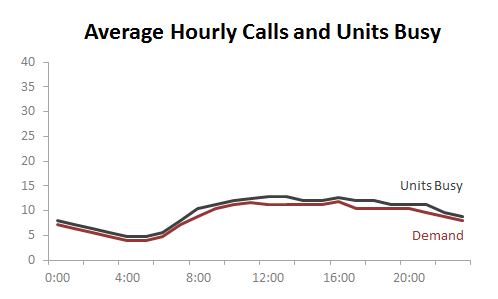Crew scheduling is a challenging and poorly-understood aspect of planning. Larger services attempt to match scheduled vehicle levels to average call levels as they change throughout the day.
What makes this difficult is the number of constraints that must be satisfied:
- Eligible shift lengths and changeover times
- Fleet size
- Station capacities
- Crew preferences
To make matters worse, during peak daytime hours, response times are typically longer. Roads are more congested, the call mix is more time intensive, and for ambulances, hospital turnarounds are slow at best. Scheduling dozens of crews in space and time is a profoundly difficult task.
Most planners rely on gut feel or software that attempts to match hourly staffing levels to average demand. Typically the demand and resulting schedule will look something like the figures below.


There are three main issues with traditional scheduling methods:
- Most software tools inaccurately represent economies of scale. They either over- or under-staff during peak times. In a typical system, this will result in a performance hit of between 0.5 and 1.0 per cent.
- The cost of shift inflexibility is hidden. Our research has shown that relaxing shift constraints even slightly (by allowing a wider range of start times and a 10- or 8-hour shift) makes a major difference. Resulting schedules will better fit the demand profile and, consequently, improve performance in the order of 0.5 per cent.
- Required fleet size is inflated. Twelve-hour shifts in particular are quite costly. They often lead to a larger fleet than necessary (note the peak number of units needed around 4 p.m. in the example above). We have seen schedules that reduce the peak fleet by 10 per cent but give the same performance with the same number of unit hours.
If you have the ability to demand schedule, adjust start times, or set alternate shift lengths, then you have the potential to use scheduling as a means to improve performance. Have your data analyst pull the data on how many units are busy (on average) at each hour of the day. The profile of this dataset should be what you match your shifts to. This can improve your performance with little or no added costs.



